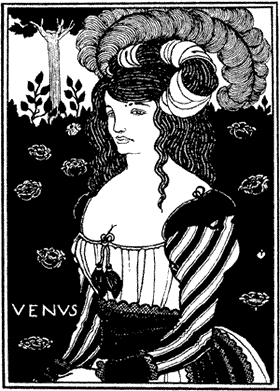

Under the Hill: A note on the text
¶ In spite of intensive efforts, writing, revising and and endless polishings of the enamelled phrases of Under the Hill, at Beardsley’s death his “romantic novel” remained unfinished. His original and heavily re-worked manuscript draft is preserved in the Rosenbach Foundation library in Philadelphia.
The history of the the novel’s publication is highly complex. Having originally offered the book to John Lane, in the event the early chapters were first published in serial form by Leonard Smithers in early numbers of The Savoy. On Smithers’s bankruptcy, Lane acquired all the surviving material for the book, including most of the pictures, and in 1904 issued a heavily Bowdlerised illustrated version of the manuscript in a handsome quarto volume: as had Smithers in The Savoy, Lane published the work as Under the Hill. In 1907 Smithers himself issued a pirated version, this time, however, under Beardsley’s original title, The Story of Venus and Tannhäuser, printed without illustrations and with Smithers’s usual typographic panache completely absent, was limited to 300 copies “for the use of literary students who are also admirers of Beardsley’s wayward genius”. Its chief merit lies in the fact that it makes available a much fuller text than had Lane.
Precisely in what way Beardsley would have developed his story and his characters, and what other bizarre and fantastical episodes he might have introduced, must ever remain a mystery. From various oblique mentions of his plans, however, and most importantly from the long and elaborate explanatory title given on the double-page spread which Beardsley had originally intended to open the book, it is clear that he envisaged that his version would to a large extent follow the original Tannhäuser legends: mention is made of Tannhäuser’s further journeying to Rome, and we may presume that there would have been descriptions of his audience with the Pope, of his repentance, and of the “miraculous burgeoning of the Papal staff” which symbolised Tannhäuser’s attainment of a state of Grace.
Nevertheless, it is equally clear that Beardsley intended a final twist to the story, in which Tannhäuser made one more return to the “loving mountain” of the Venusberg. This last episode formed the subject of the poignant drawing, reproduced from the line-block, on the preceding page, which the artist made and presented to J. M. Dent, his first publisher, in thanks for Dent’s granting of permission to reproduce a number of Beardsley’s early designs to which he owned the copyright.
In common with recent editors, we have compiled the present text from the three early printed sources mentioned above in order to include in a single version all the best passages of Beardsley’s writing. We have eliminated, however, certain infelicitous repetitions of both phrase and style which, due to the fragmented nature of the text, were allowed to creep into both Lane’s and Smithers’s later versions. We have also retained the title by which the work is best known.
